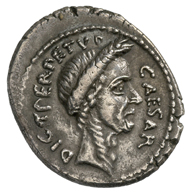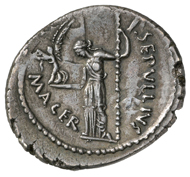with the kind permission of the MoneyMuseum, Zurich.
At the beginning of the year 44 BC, the Roman Senate conferred a whole host of honours never before possessed by a Roman upon Caesar. He was proclaimed ‘dictator in perpetuity,’ was permitted to wear the triumphator’s garb whenever he pleased, and, what’s more, also to depict his own image on coins, like a Hellenistic ruler.
Did Caesar wish to become king? It’s a question that all Romans asked themselves at the time and many historians still ask today. And it still hasn’t been answered conclusively. And yet, with his coins, Caesar himself offers a clear indication as to how he saw himself.
Roman Republic. Denarius, minted under P. Sepullius Macer, 44 BC. Head of Caesar, facing right, bearing the Etruscan gold crown. Rev., Venus Genetrix with sceptre standing facing left, in her outstretched hand, a Victoria, rushing towards the left to decorate someone with the wreath that she holds in her hands. © MoneyMuseum, Zurich.
Taking a close look at the wreath worn by Caesar on his coins, what is striking is that it’s not the laurel wreath familiar to us from later emperors – the headdress is made up of small lamina and globes. We know these wreaths from archaeology – they were made out of gold by skilled artisans and have survived on Etruscan paintings and in their original form from grave finds.
The Romans had adopted it from the Etruscans. It was worn by the victorious commander on that one day when, in a spectacular procession, he offered his sacrifice to Jupiter. It was used to decorate the officer under whose authority the games were opened. As such, the golden crown was a trusted symbol to Roman citizens. It served as a reminder of victory, of stately achievements, of responsibility and of many other virtues that could be expected of one’s politicians.
Like many other aristocrats, Cicero also felt politically patronized by Caesar. Bust of Cicero in the Capitoline Museums, Rome. Photo: Glauco92 / http://creativecommons.org/licenses/by-sa/3.0/deed.en
And in fact, shortly after taking power, Caesar put in place a program of reforms so quickly and so effectively that the Romans had never before seen anything of its kind. Although it’s understandable that he could no longer take into consideration the viewpoints and interests of each of the by then 900 senators, the former rulers of the empire did not take at all kindly to the reforms. Cicero declared, resignedly: ‘Where we once sat at the rear at the helms [of the ship of state], today there is barely any room for us in the bottom water.’ After all, what sense was there in running for office when the path to exerting any real influence remained blocked?
And so, it wasn’t freedom for all that the conspirators were hoping to gain by murdering Caesar, but rather their right to play for power and influence as they had done before. The ramifications of the assassination led, however, to a civil war, which took at least as many lives as did Caesar’s conquest of Gaul. Only this time it was Roman, not foreign, blood that flowed.
In the next chapter, you’ll learn how Caesar’s heir Augustus cleverly constructed a new image following a bloody civil war – also with the aid of coins.
All sections of the series can be found here.
The book ‘MenschenGesichter’ is available in printed form from the Conzett Verlag website. It soon will be translated to English. …








